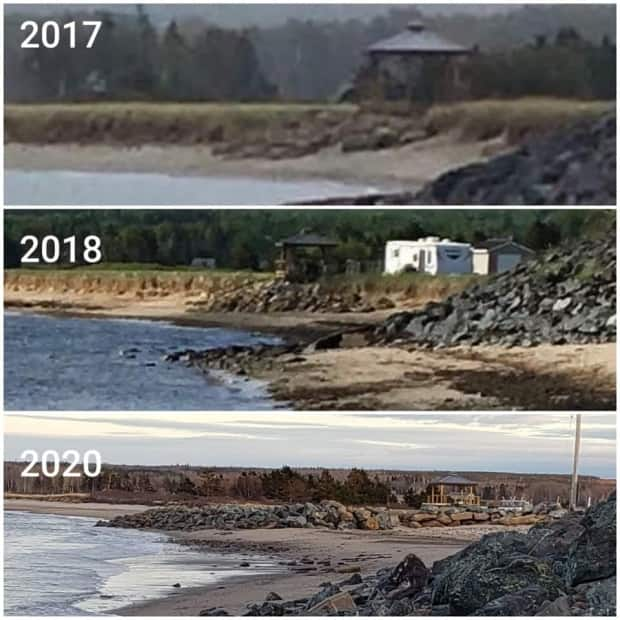Black Point landowners take their James Beach fight to the Supreme Court
Three landowners from Black Point in Pictou County took their fight over rocks on a beach to Nova Scotia Supreme Court Wednesday.
The judicial review is examining the province's approval of a rock retaining wall on James Beach.
The people taking the issue to court are upset that the rock wall blocks their access to the beach and say the right for the public to walk along any beach in the province is at the core of the issue.
Legal costs are being covered by a $15,000 crowdfunding effort.
"It has been worthwhile for me ... to see the community come together and protect our beautiful beach," said Maryn Lynn, one of the applicants who owns property on James Beach.
Wayne and Helen Chisholm built the armour stone rock wall at James Beach, northeast of New Glasgow, in 2017.

It crosses the width of the beach, before turning 90 degrees and running parallel to the water. The base of the wall sits in more than a metre of water at high tide, and it's been repaired and expanded as it's damaged by the ocean.
After community complaints, the province determined the wall is legal, because Nova Scotia landowners are allowed to replace existing retaining walls even when the shoreline has moved farther inland.
The Chisholm family declined to comment Wednesday. Nova Scotia's Department of Lands and Forestry won't comment while the case is before the court.
Hoping for a reassessment
A judicial review can't order the wall to be changed or removed, but it could send the matter back to the minister of Lands and Forestry if the approval process is found lacking.
"We're hopeful that at the very least, the government will take another look at this decision," Lynn said.
"This is not about erosion protection, because all of the people in our neighborhood do erosion protection," said Beth Skerrett, another applicant.
"We're very much in support of erosion protection. The problem for us is the beach access. So having beach access to walk along the front of any beach in Nova Scotia is really the core of this issue," Skerrett said.
Erosion and accretion
The lawyer for the applicants, Jamie Simpson, said legal arguments hinge on where Crown land ends and private land begins.
Normally, all land below the mean high water mark is owned by the government, allowing public access to the entire length of a beach. If the shoreline moves, so does that boundary.

Simpson says aerial photographs dating back to the 1990s show those kinds of shoreline shifts on James Beach.
"Sometimes land is added to the sand spit, and sometimes land is taken away.... We see erosion and accretion happening over the scale of years and decades," Simpson said.
If private land is suddenly ripped away, Simpson said landowners have the right to fill it back in.
But on James Beach, he argues that's not the case.
Simpson said the government never gave a "cohesive, logical argument as to why the boundary hasn't moved."
"The minister has to come up with a more robust way to make these decisions, not to make what appears, from the outside, to be something of an arbitrary decision," he said.
Provincial significance
Lynn and Skerret say their legal challenge could resonate for all Nova Scotia beaches.
"I think this issue is very important if we consider climate change, which is not going away," said Lynn. "This is about whether or not the general public, and not just coastal property owners, will have access to the beach below the ordinary high water mark."
Skerret added: "Today is not whether it was a good decision or a bad decision for this family to build the wall. The decision here is, did the government make the right decision by allowing them to build the wall where they built it?"
Justice Ann Smith reserved her decision at the close of Wednesday's hearing.
MORE TOP STORIES

